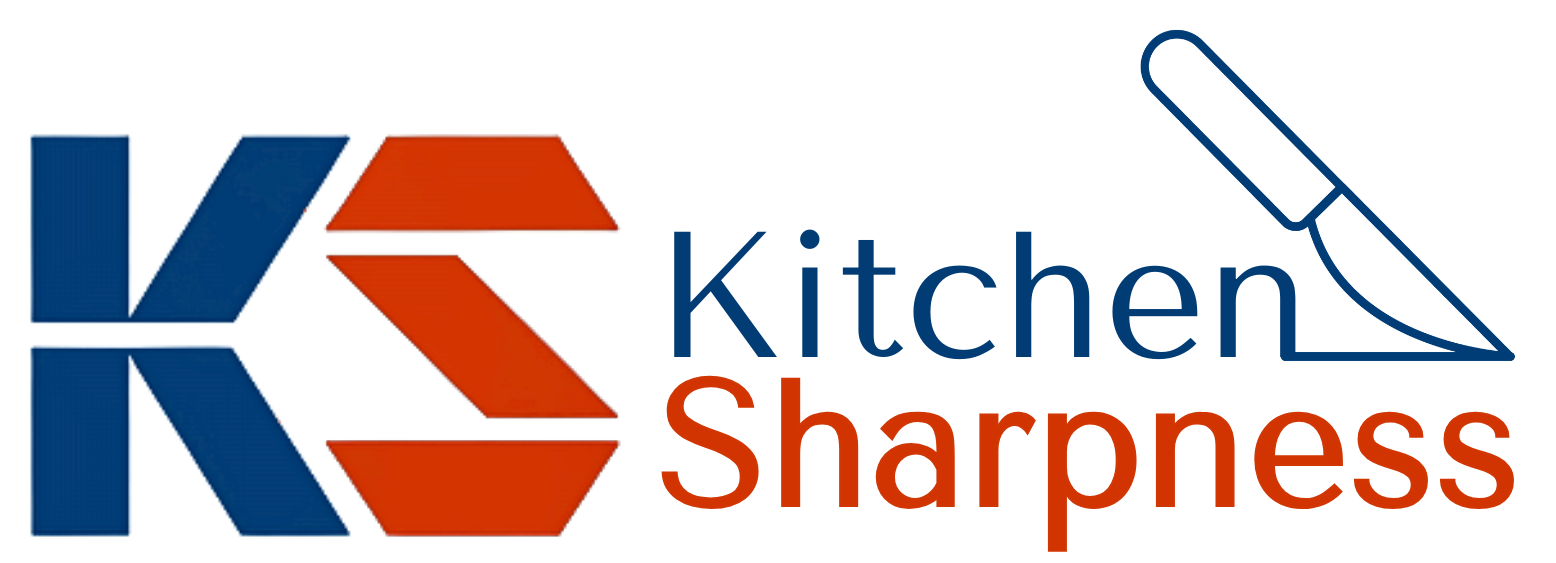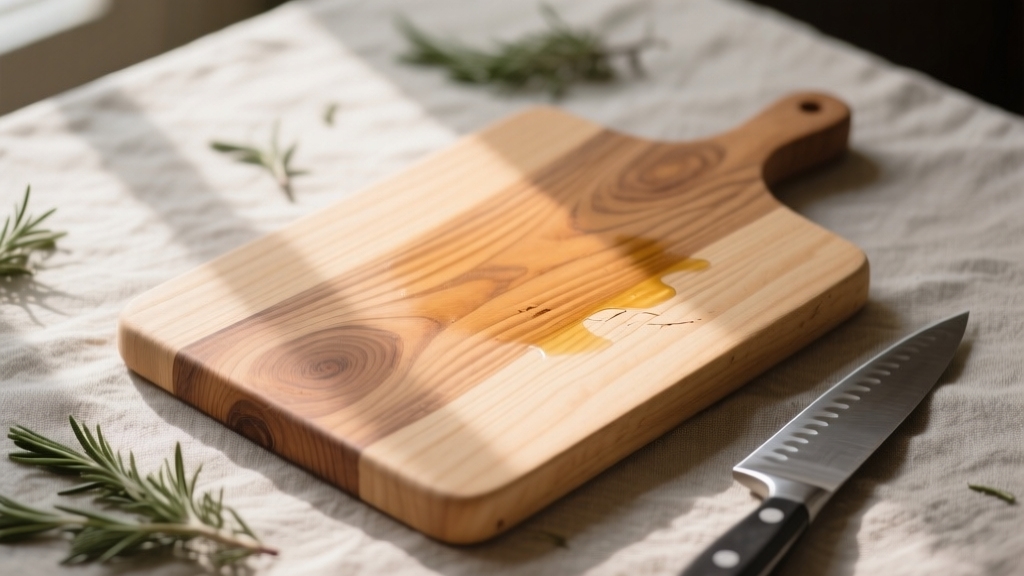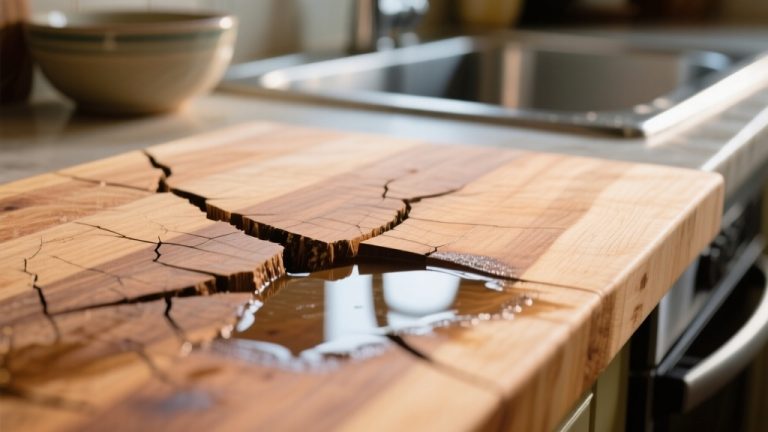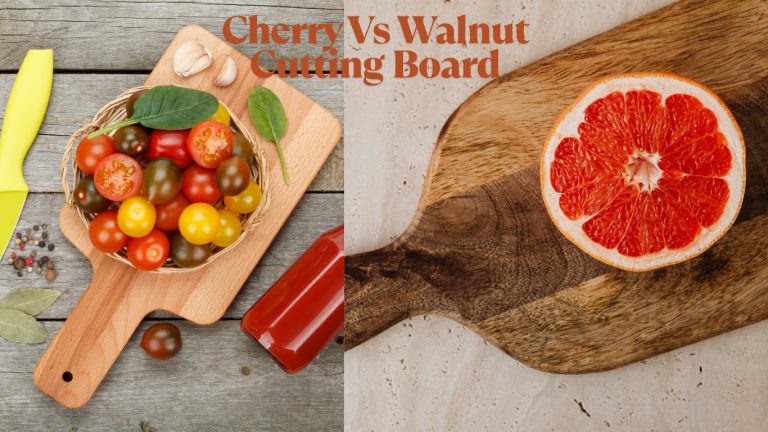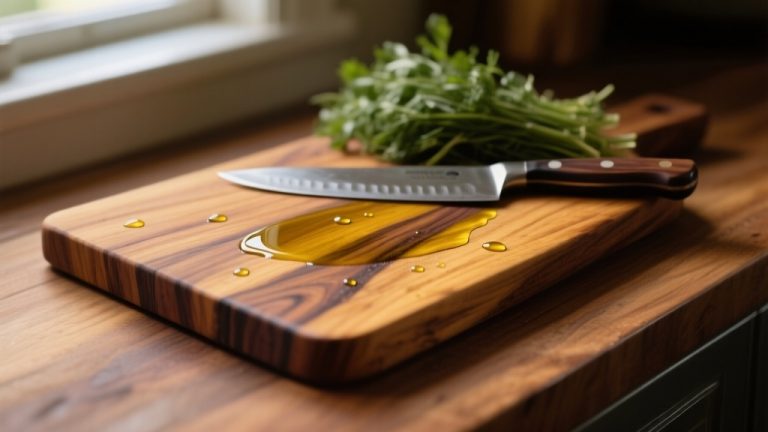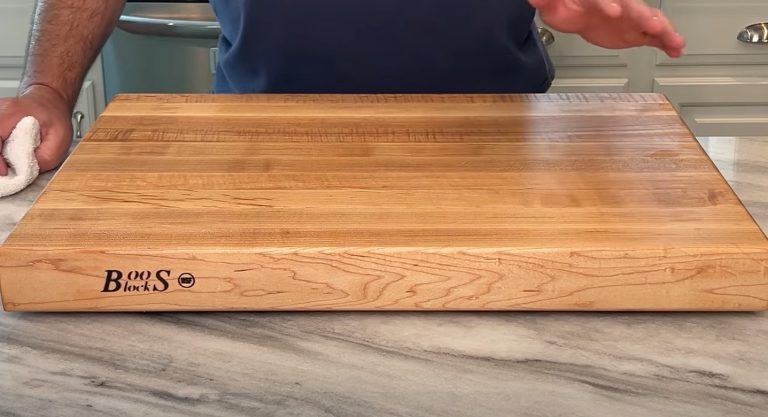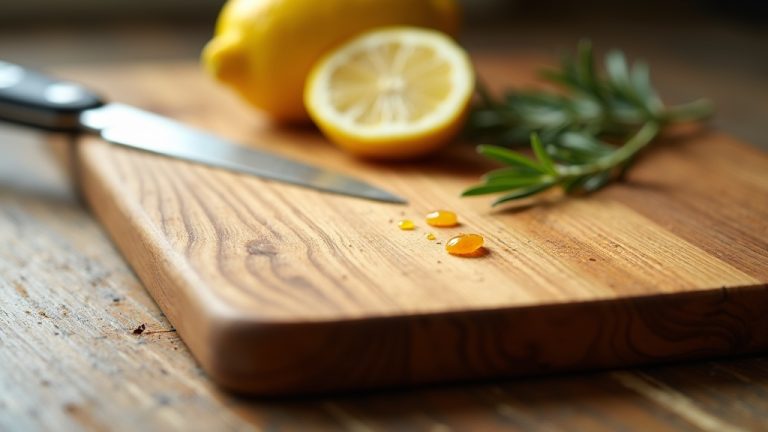Is Beech Good for Cutting Board Use in Your Kitchen?
Beech makes an excellent cutting board choice because it balances durability and knife-friendliness with a dense, closed grain that resists warping, stains, and bacteria. Its natural antibacterial properties help keep your board sanitary, while its fine grain creates a smooth, low-porosity surface that’s easy to maintain.
With proper oiling and care, you’ll enjoy a long-lasting, stable cutting surface that’s also environmentally responsible and cost-effective. Explore further to uncover best practices, potential drawbacks, and maintenance tips.
Key Takeaways
- Beech’s dense, closed-grain structure resists warping, cracking, and bacterial buildup, making it hygienic for cutting boards.
- Its moderate hardness protects knives while offering durability against scratches and dents from daily use.
- Beech naturally inhibits bacterial growth due to tannins and resins, enhancing food safety on its surface.
- The wood’s smooth, fine grain provides a clean, knife-friendly surface that resists stains and odors.
- Affordable, sustainably sourced, and easy to maintain, beech cutting boards offer excellent value and environmental benefits.
Durability and Hardness of Beech Wood
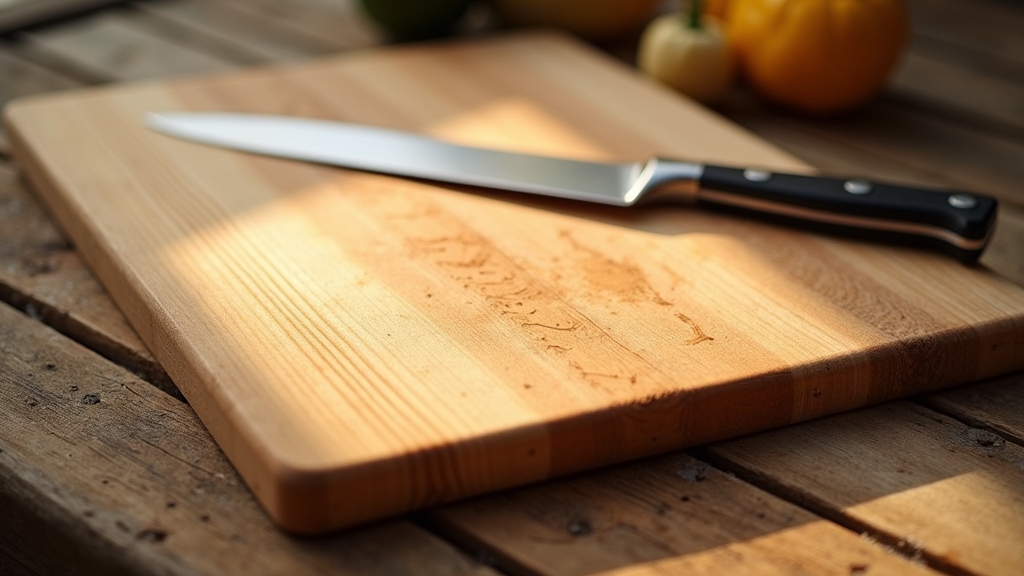
While selecting a cutting board, you’ll want a material that balances durability with knife-friendliness, and beech wood fits this profile well.
With a Janka hardness rating around 1300, beech offers moderate hardness, being harder than many softwoods but softer than maple or bamboo, so it resists scratches and dents without dulling your knives excessively.
Its dense, tightly structured cells provide excellent resistance to warping and cracking under kitchen conditions. Beech’s small pores limit stain absorption, helping the board maintain its appearance over time.
Regular conditioning with food-grade oils helps preserve its hardness and prevents drying or cracking. Additionally, beech wood contains natural antibacterial properties that help fight bacteria and maintain hygiene.
Using the right sharpening tools is essential to keep your knives effective and prolong the life of your cutting board, and beginners often benefit from water-based sharpening stones for easy maintenance.
Compared to other hardwoods, beech offers solid durability at a reasonable cost. It makes a reliable choice for daily cutting tasks while ensuring longevity and hygiene.
Surface Smoothness and Grain Characteristics
Because beech wood features a tight, closed grain pattern and fine, straight grain, it provides a consistently smooth surface that’s ideal for cutting boards.
You’ll appreciate how this grain structure minimizes gaps, reducing places where food particles or bacteria can hide. Its surface smoothness also helps in reducing wear on knife edges, preserving blade sharpness longer.
Beech wood’s tight, closed grain creates a smooth, hygienic surface perfect for cutting boards.
The surface accepts oils and finishes evenly, creating a polished, knife-friendly board that balances hardness with blade protection. Beech wood’s low natural porosity helps resist liquids and odors, making it a hygienic choice for kitchenware. When you maintain the board properly, it resists moisture absorption and surface wear effectively.
- Tight, closed grain limits cracks and crevices, enhancing hygiene.
- Fine, straight grain ensures a uniform, smooth texture.
- Even finish uptake produces a polished surface that reduces knife marks.
- Moderate porosity demands regular oiling to preserve smoothness and durability.
Natural Antibacterial Properties of Beech

Although many woods possess some antibacterial qualities, beech stands out due to its natural compounds like tannins and resins that actively inhibit bacterial growth on its surface.
These compounds create an environment hostile to microbes, reducing bacterial survival intrinsically within the wood fibers. Studies confirm that unfinished European beech cutting boards harbor fewer recoverable bacteria than many alternatives, as the wood’s porous structure encapsulates and isolates microorganisms, limiting their proliferation.
This self-sanitizing effect surpasses synthetic boards, which can trap bacteria in scratches. Beech’s dense grain and hardness further minimize deep cuts, reducing bacterial accumulation. Proper maintenance techniques ensure these antimicrobial properties remain effective over time.
By choosing beech, you leverage its proven antimicrobial properties, enhancing kitchen hygiene naturally without relying on chemical treatments or coatings that may block these benefits. However, it is important to note that proper handling and maintenance are crucial regardless of the surface material to ensure optimal hygiene.
Workability and Maintenance Requirements
Beech’s natural antibacterial qualities make it an excellent choice for cutting boards, but understanding its workability and maintenance will help you maximize its performance and lifespan. You’ll appreciate its fine texture and moderate hardness, which balance durability with gentleness on knives.
Its durability and hardness ensures the board withstands frequent kitchen use without losing structural integrity. Regularly applying a food-safe sealant can greatly enhance its moisture resistance and longevity.
Beech offers natural antibacterial properties with a fine texture and balanced hardness, ideal for durable, knife-friendly cutting boards.
To keep your beech board in top shape:
- Oil it monthly to prevent drying and cracking, maintaining moisture balance.
- Clean with mild soap and water; never soak or use a dishwasher to avoid warping.
- Occasionally apply food-safe wax for added surface protection.
- Sand lightly when needed to remove cuts and restore smoothness without thinning the board excessively.
Appearance and Aesthetic Qualities
When you choose a beech cutting board, you get a wood with a light, creamy white to soft pinkish brown color that offers a clean and consistent look ideal for any kitchen style. Its uniform tone and tight, fine grain create a smooth, polished surface that complements both modern and traditional decor.
Beech’s subtle elegance stems from its understated grain pattern and ability to accept finishes evenly. This results in a warm, matte to semi-gloss sheen. Over time, the board develops a richer patina, adding depth without drastic color change.
While its pale shade may show stains more readily, regular care preserves its fresh appearance. Due to its high Janka hardness, beech cutting boards resist wear and maintain their aesthetic appeal longer.
Additionally, regular maintenance such as sharpening knives used on the board helps keep the surface smooth and intact. Beech’s visual durability combines practicality with understated beauty, making it a smart, attractive choice for cutting boards.
Comparison With Other Hardwood Cutting Boards
If you’re weighing your options among hardwood cutting boards, understanding how beech stacks up against other popular woods is essential. Beech offers a balanced combination of hardness, moisture resistance, and affordability. Here’s how it compares:
- Hardness: Beech’s 1300 Janka rating is slightly softer than hard maple’s 1450 but harder than walnut and cherry. This provides moderate durability and knife friendliness. Proper knife maintenance can extend the life of cutting boards by reducing blade wear.
- Moisture Resistance: Beech’s fine pores resist bacteria and moisture better than open-grained woods like pine. However, it’s marginally less resistant than maple. Additionally, its small pores make it resistant to stains and bacteria, enhancing its safety for food use.
- Maintenance: Beech needs regular oiling to prevent warping. Maple is similar but slightly more knife-friendly. Walnut and cherry require less frequent care. Regular cleaning with hot water and mild detergent is recommended to prevent bacterial buildup.
- Cost: Beech is more affordable and widely available in Europe, making it a cost-effective choice compared to pricier maple and walnut. Choosing woods that are easier to clean and sterilize can reduce long-term costs related to food safety.
Environmental Impact and Sustainability
You’ll appreciate that beech wood comes from renewable forestry, where responsible harvesting techniques maintain forest health and guarantee a steady supply. Eco-friendly manufacturing processes further minimize environmental impact by adhering to strict sustainability standards.
Choosing beech means supporting practices that balance product quality with ecological responsibility. Additionally, beech cutting boards are biodegradable and free from the microplastics contamination commonly associated with plastic boards.
Its durability and ease of maintenance make beech a practical and sustainable choice compared to other kitchen tools materials.
Renewable Resource Benefits
Because beech wood comes from sustainably managed deciduous hardwood trees, it serves as a renewable and biodegradable material ideal for cutting boards. You benefit from its renewable nature, as responsibly harvested beech trees can be replanted, ensuring ongoing forest health.
Additionally, beech wood naturally biodegrades, minimizing environmental impact compared to plastics. Wood products like beech cutting boards also continue to store carbon during their lifespan, contributing to environmental sustainability through carbon storage.
Many kitchen products made from wood, including cutting boards, offer easy maintenance compared to synthetic alternatives.
When you choose certified beech wood, you support forest regeneration and biodiversity. At the end of its life, the board can be recycled or repurposed, reducing landfill waste.
Key renewable resource benefits include:
- Sustainable harvesting and replanting maintaining forest ecosystems.
- Biodegradability preventing harmful residues.
- Carbon sequestration stored in wood, mitigating climate change.
- Extended product lifespan lowering resource consumption and waste.
Eco-Friendly Manufacturing Practices
Choosing beech wood for cutting boards supports sustainable forestry, but the environmental benefits extend beyond raw material selection to the manufacturing process itself. When you select beech, you benefit from efficient energy use during sawing, drying, and finishing stages.
Manufacturers often repurpose sawdust and offcuts as biomass fuel, minimizing waste. Using water-based finishes and non-toxic adhesives further reduces chemical emissions, maintaining eco-friendly standards.
Heat treatments improve durability without harmful additives, extending product life and lowering environmental impact. Beech’s dense, closed-grain structure resists moisture and damage, so your cutting board lasts longer, reducing replacement frequency. Additionally, each cutting board is handcrafted to emphasize quality craftsmanship, which promotes careful use of materials and attention to detail.
Additionally, responsibly sourced beech, certified by FSC, ensures sustainable harvesting and limits transportation emissions when processed near forests. Your choice encourages manufacturers to adopt greener, leaner production practices, fostering a truly sustainable product lifecycle.
Best Practices for Using Beech Cutting Boards
When handling a beech cutting board, maintaining its durability and hygiene requires consistent care tailored to its specific characteristics.
To keep your board in prime condition, follow these best practices:
Maintain your beech cutting board’s quality by following essential care tips for durability and hygiene.
- Clean gently with mild soap and water immediately after use, avoiding soaking to prevent warping. Using proper tools such as a knife sharpener can help maintain the cutting edge and reduce deep cuts on the board.
- Apply food-safe mineral oil regularly to protect against moisture damage and preserve the wood’s natural sheen.
- Thoroughly dry the board after washing to inhibit bacterial growth and prevent shrinkage. Beech, as a closed grain wood, has fewer pores which helps limit bacteria absorption.
- Periodically sand the surface to remove knife marks and restore smoothness, enhancing both hygiene and cutting precision.
Common Issues and How to Prevent Them
You’ll need to manage moisture carefully to prevent beech cutting boards from warping or cracking, as uneven drying and environmental changes cause stress in the wood. Proper storage, such as drying boards on their edges and avoiding direct sunlight, is essential to maintain stability and prevent warping issues.
Regular oiling and proper sealing help avoid stains and lingering odors, but over-application can trap moisture and worsen issues. Additionally, using maintenance techniques like regular cleaning and inspection can prolong the lifespan of your beech cutting board.
Preventing Cracks and Warping
Although Beech cutting boards offer durability and aesthetic appeal, preventing cracks and warping requires careful attention to moisture management and construction techniques. You must guarantee balanced moisture exposure and select materials that minimize internal stresses.
To effectively prevent these common issues:
- Use kiln-dried Beech wood with moisture content between 6-8% and opt for glued-up strips with uniform hardness to avoid expansion mismatches.
- Choose thicker boards or laminate with alternating grain directions to enhance dimensional stability.
- After washing, dry the board evenly on both sides and store it elevated to promote uniform airflow. Turning the board over so the convex side faces up and allowing it to rest naturally can help flatten warping by equalizing moisture content on both sides moisture equalization.
- Regularly apply mineral oil or beeswax to seal the surface, reducing moisture absorption and maintaining balance.
Avoiding Stains and Odors
Because Beech wood’s porous nature readily absorbs pigments and odors, you must take proactive steps to prevent staining and lingering smells. Avoid cutting highly pigmented foods like beets or turmeric directly on your board, and never soak it in water or use harsh chemicals.
After washing, dry your board thoroughly and store it upright with good airflow to inhibit bacterial growth. Immediate Washing with warm, soapy water after each use is essential to maintain cleanliness. Regularly apply food-grade mineral oil or a mineral oil and beeswax blend to create a moisture barrier.
To tackle stains, gently rub salt or baking soda paste on affected areas, then rinse with warm water. For odors, use a diluted vinegar soak or rub with lemon juice and salt.
Cost-Effectiveness and Availability in the Market
When evaluating cutting boards, you’ll find beech stands out for its cost-effectiveness and wide availability. You get durable boards priced typically between €60–€98, often cheaper than maple or walnut, making beech a smart investment. Its moderate hardness guarantees longevity without excessive knife wear, reducing replacement frequency.
Additionally, beech wood is widely sourced from sustainably managed European forests, available in various sizes and thicknesses both industrially and artisanally. Beech boards are often handcrafted for durability and sturdiness, enhancing their overall quality. Consider these factors:
- Competitive pricing against premium hardwoods and bamboo.
- Broad market availability, including XXL sizes and handcrafted options.
- Long lifespan with proper maintenance, enhancing value.
- Sustainable sourcing appealing to eco-conscious buyers.
Frequently Asked Questions
Can Beech Cutting Boards Be Used for Both Raw Meat and Vegetables?
Yes, you can use beech cutting boards for both raw meat and vegetables, but you should keep them separate to avoid cross-contamination. Beech’s dense grain is durable and safe, but thorough cleaning and sanitizing after raw meat use is essential.
Always wash with hot, soapy water, sanitize, and let the board dry completely.
Regularly oil the board and replacing it when cut marks deepen will keep it safe and long-lasting.
How Does Beech Wood React to Dishwasher Cleaning?
Imagine treating your beech cutting board like a knight’s armor in a medieval forge; dishwasher heat and moisture will warp and crack it. You shouldn’t use dishwashers on beech wood—they cause swelling, leaching protective oils, and surface cracking.
Instead, hand wash immediately with warm, soapy water.
Dry upright, and oil regularly. Avoiding dishwasher exposure preserves its structure and lifespan, keeping your board hygienic and durable for years to come.
Are Beech Cutting Boards Safe for Children to Use?
Yes, beech cutting boards are safe for children to use. They’re made from dense, non-toxic wood without harmful chemicals, complying with strict safety standards like GREENGUARD GOLD.
Their smooth surface minimizes injury risk, and food-safe finishes protect the wood while being child-friendly.
When you maintain the board properly—hand wash, dry immediately, and oil regularly—it stays hygienic and durable, making it ideal for kids learning to prep food safely.
What Is the Average Lifespan of a Beech Cutting Board?
You know what they say: “A stitch in time saves nine.” The average lifespan of a beech cutting board is typically 5 to 10 years. If you maintain it well—regular oiling, hand washing, and proper storage—you’ll keep it durable and functional.
Beech’s hardness resists wear, but moisture and staining need attention. With consistent care, your beech board will serve you reliably for years without warping or cracking.
Can Beech Cutting Boards Be Customized With Engravings or Logos?
Yes, you can customize beech cutting boards with engravings or logos. Their straight grain and light color highlight precise, durable laser engravings perfectly.
You’re able to choose from various fonts, sizes, and designs, including logos, text, or custom motifs.
Just keep in mind that engraving depth is controlled to preserve board usability.
Many providers offer personalized options, making these boards ideal gifts or branded merchandise for businesses.
Make Beech Your Cutting Board of Choice Today
Choosing beech for your cutting board is like selecting a steadfast guardian for your kitchen. It is durable, smooth, and naturally protective. Its fine grain and antibacterial qualities ensure your food preparation stays safe and efficient.
While it demands proper care, its sustainability and cost-effectiveness make it a wise investment. By honoring beech’s strengths and addressing its needs, you invite a reliable partner that blends beauty and resilience.
Beech stands strong through every culinary challenge you face.
